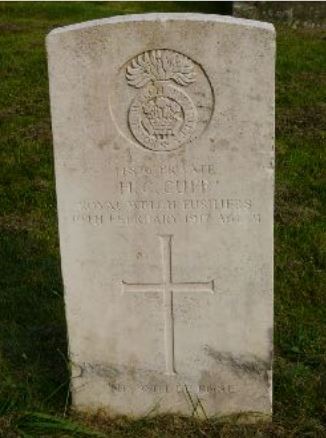11th Battalion, Royal Welsh Fusiliers

Henry Charles Cuff was born at Linton, near Churcham, Gloucestershire on 3 January 1886. His parents were Frederick Cuff (1853-1925) a shepherd and his wife Harriett (née Gwilliam: 1851-1909). The couple had at least nine children, of whom Henry was the second youngest.
At the time of the 1901 Census, Henry was employed as a printer’s stone cleaner. According to the UK Railway Employment Records 1853-1956 (made available via Ancestry) between the years of 1902 and 1906 he was employed by the Great Wester Railway at both Swindon and Gloucester as a porter.
It has not been possible to trace him in the 1911 Census. It may well be that by this time he was living in lodgings and as his Army enlistment papers show his occupation as a collier, he was possibly located in either the South Wales coalfields or those of the Forest of Dean.
An Army Pension Record has survived for Henry, which gives some helpful details of his military service and reason for discharge.
He enlisted on 2 September 1914, for an initial three years with the Colours. He was posted to the Royal Welsh Fusiliers and joined them at their Depot in Wrexham and was assigned the number 14876. On 14 September 1914 he was assigned to the 11th (Service) Battalion and trained with them at Seaford and St Leonards in Sussex and at Aldershot before the battalion was sent to join the British Expeditionary Force (BEF) in France on 5 September 1915. The battalion was part of 67 Brigade, 22nd Division and saw no significant action in the short time it was deployed there.
On 23 October 1915 it was ordered to join what was known as the Mediterranean Expeditionary Force (MEF) and made the long rail journey through France to the port of Marseilles, from which it sailed on the 30th, arriving in Salonika, northern Greece (now Thessoloniki) on 5 November. ere it joined an Anglo-French expeditionary force fighting the Bulgarians.
In November 1915 Henry became unwell, exhibiting what was at first thought to be bronchitis. His condition did not improve and he began to show the classic signs of having pulmonary tuberculosis. He was sent to a convalescent camp for six weeks and given light duties but collapsed in February 1916. A medical board attributed his condition to active service hardship and exposure and sanatorium treatment was recommended. He remained in Salonika and was reported as seriously ill on 21 May 1916. On 19 June he was despatched to England, via Malta.
On 8 August 1916 he was formally discharged from the Army, as unfit for further war service and was issued with a Silver War Badge, to denote his discharge from military service. Initially he was granted a 50% disability pension but this was upgraded to total incapacity on 22 December 1916.
He returned home and his condition steadily deteriorated and he died on 19 February 1917, aged 31. He was buried in the churchyard of Highnam Parish Church, where a standard CWGC headstone marks his grave. His name was included on a war memorial tablet installed inside the church in April 1921.
Researched by Graham Adams 26 March 2020
